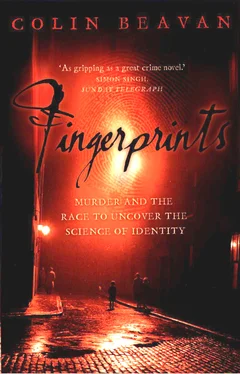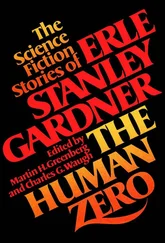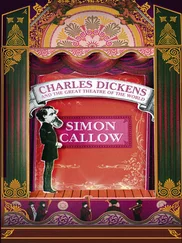Vidocq wound his way through the criminal haunts of Paris, scavenging for information about the necklace. In only three days he discovered the identity of the thief and the location of the jewels. Napoleon, delighted, demanded to meet the strange rogue who found his ex-wife’s treasure. In a gesture of gratitude, he ordered that the thirty-four-year-old Vidocq be appointed to a police position worthy of his talents, and the now-transformed Vidocq began his crime-fighting career as an underworld spy. Continuing to pose as a fugitive, he pretended to play an active role in the planning of crimes, but secretly tipped off the police before they were perpetrated. Vidocq’s crime-fighting tactics were so successful that, three years later, the police prefect Comte Jean Dubois signed an order establishing the Sûreté with Vidocq at its helm.
Vidocq hired eight assistants, who, in line with his philosophy on criminals catching criminals, were all former convicts with vast underworld knowledge. Their work earned Vidocq rapid acclaim. By 1814, he was made a deputy prefect, and in the year 1817 alone, Vidocq and his expanded force of thirty detectives arrested 812 murderers, thieves, burglars, robbers, and embezzlers.
In his years as chief of the Sûreté, Vidocq singlehandedly launched police procedure out of the Middle Ages and into the nineteenth century. He developed the “undercover” technique, planting in the criminal world agents who kept him one step ahead of his quarry. He instituted an early system of criminal identification, recording the descriptions of each criminal’s appearance and method of work. Using plaster casts of crime-scene boot prints, he sent thieves to jail by identifying the tread of their boots. In 1822, before ballistic science began, Vidocq solved the case of a murdered Comtesse with the bullet he removed from her head. He proved that it was too big to have been fired from her husband’s gun, but just the right size to have come from her lover’s.
Vidocq never hesitated to brag about these exploits, especially while drinking in the watering holes of Paris’s most famous writers. Hugo, Balzac, Dumas, and Sue all hungrily feasted on his tales, recounting them in their newspaper columns and novels. Victor Hugo, for example, based both Jean Valjean and Inspector Javert, characters in Les Misérables , on the detective. The exposure made Vidocq a celebrity, and his sleuthing methods were studied by police officers around the world. Vidocq’s fame gave a kick start to professional police detection, and stories of his use of physical evidence and nascent forensic techniques softened the ground for the eventual introduction of fingerprinting.
Yet the detective force that would introduce fingerprinting, a Sûreté-style branch of London’s Metropolitan Police, had not yet been started. Governments throughout Europe envied France’s Sûreté, but the British felt that a secret detective force was uncomfortably reminiscent of a police state. Then, in 1842, two London murders caused a public outcry that changed their minds.
One of the murders occurred when a suspect chased by police constables turned and shot two of them, one fatally. That a criminal possessed a gun was virtually unheard of in those times; that he would actually use it against policemen demonstrated a disregard for human life that disgusted even most outlaws. The shooter could only have come from the most depraved of criminal backgrounds. Why was he not known to the police?
It emerged that Thomas Cooper, the shooter, was indeed known to be extremely dangerous, at least at the Scotland Yard, London’s police headquarters. He belonged to a violent London gang and had a long criminal record. Local police had no idea that such a dangerous felon was holed up in their neighborhood, however, and they walked right into his loaded gun. This outraged the citizens of London. The Yard might as well have let children swim in shark-infested water. And this was the second example of headline-grabbing police ineptitude in only a month.
One evening a few weeks before, a shoplifter left a tailor’s shop followed by two salesmen, staying a few steps behind. They’d seen him surreptitiously slip a pair of trousers under his coat. On the street, they quickly related their tale to a passing police constable, and the three followed the thief to the stables where he worked. They confronted the shoplifter, but he denied the theft, so the constable and the salesmen searched the stables for the trousers. Under the hay, the constable uncovered what at first he thought was a plucked goose. Suddenly, the shoplifter rushed out of the stable, closed and locked the door, and imprisoned his pursuers long enough for him to make his escape.
At first, the constable did not understand why his discovery in the hay had scared the shoplifter away. But when he dug the object from the straw, a terrible realization dawned on him. What he had found was not a goose at all but the headless torso of a woman. Later, a noxious odor in the stable’s harness room led investigators to the fireplace, where they found the charred remains of her head and limbs. They also discovered the ax, covered with traces of blood, that had been used to dismember her. The man the constable thought was only a shoplifter had apparently killed a woman and tried to cremate her body, piece by piece. Now he was at large.
The shoplifter’s name was Daniel Good. A convicted criminal with a two-year prison record, Good had a reputation for temper and violence, and in a fit of rage, he had once torn the tongue from a horse’s mouth. These facts were plainly written in the dusty files of Scotland Yard, yet, again, no one had alerted the local police. The result was that the constable on the scene, with all the dimwitted sluggishness that had lately tainted the reputation of the Metropolitan Police, had been given the slip by a criminal much more dangerous than a petty thief.
The public was furious. Nor did the force redeem itself in the search that followed. More than once, when a tiptoe approach was needed, the clodhopper police alerted Good to their impending approach, sending him back into hiding. Eventually Good was apprehended, tried, and hanged for the murder of his common-law wife, but the Yard was lambasted in the press for its inability to undertake the simplest forms of criminal detection.
After the poor handling of the Cooper and Good cases, the reputation of the Metropolitan Police hit an all-time low. So, on June 20, 1842, the government, under pressure from the police commissioners and spurred by the need to repair a red-faced image, finally gave permission for the experimental establishment of a “Detective Force.” It began with twelve policemen, transferred from their normal duties, who taught themselves the work of detectives out of three small rooms in Scotland Yard.
The eventual parent to fingerprinting was finally born. But there would be growing pains. The work of the new detectives was at first unsophisticated. They watched and followed suspicious characters, hoping to collar them in criminal acts. They frequented the haunts of known criminals, sometimes in disguise, drinking and carousing and collecting gossip. They searched and questioned pawnbrokers in hopes of finding stolen goods that would lead them to the thieves.
This was all to the good, but a mature detective force would also have a talent for solving crimes from disparate clues, fitting them together like jigsaw puzzle pieces that, when assembled, revealed a picture of the murderer. Twenty years would pass before British detectives first demonstrated such Vidocq-style sophistication. When they finally did, they received a huge fanfare of press acclaim for their solution of the sensational and difficult case of Britain’s first murder on a train.
The victim, seventy-year-old Thomas Briggs, was still alive when he was found between the tracks near the railway bridge at London’s Victoria Station on a Saturday night in 1864. He died a few hours later of a fractured skull. Briggs had been riding the train from London to Hackney, where he lived. The empty first-class carriage he had occupied pulled into the station, stained with blood, bearing the marks of a fierce struggle, and containing a hat, a walking stick, and a bag.
Читать дальше












